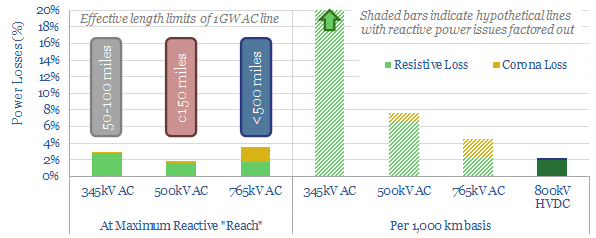Electricity transmission matters in the energy transition, integrating dispersed renewables over long distances to reach growing demand centers. This 15-page note argues future transmission needs will favor large HVDCs in energy transition, costing 2-3c/kWh per 1,000km, which are materially lower-cost and more efficient than other alternatives. What opportunities follow?
Long distance power transmission is likely to grow more important in the energy transition. There are six reasons for this claim, especially linked to wind and solar, which are laid out on pages 2-4.
The simple physics of power transmission are laid out on pages 5-7, with worked examples showing how the existing grid transmits relatively small power quantities over relatively low distances, but resistive power losses ‘blow up’ if we try to expand AC power lines.
Overcoming these challenges via higher voltages and thicker power cables is not really feasible, especially as reactive power consumption becomes the limiting factor on AC lines. Again, the techno-economic theory behind these claims is laid out on pages 8-11.
HVDC lines melt away many of the problems noted above. We outline the reasons on page 12, along with real-world data from world-leading HVDC projects that have been constructed in China since 2010.
Economics. We think HVDCs can deliver multi-GW power, over distances around 3,000km, for total transmission spreads of 5-10c/kWh. Underlying assumptions, and comparisons with other technologies — batteries, hydrogen — are given on page 13.
Who benefits? Some of the leading companies in HVDC, and interesting new project proposals are discussed on page 14.
To read more on HVDCs in energy transition and its leading companies, please see our article here.

